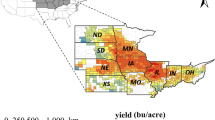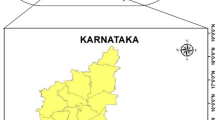The time of forcing of spatial LAI to crop models at single or multiple stages is important to simulate crop biomass and yield in varying agro-climatic conditions and scales. The high temporal resolution (5-day) by Advanced Wide Field Sensor (AWiFS) on-board Resourcesat-1 Satellite IRS-P6 with 56 m spatial resolution and large swath (740 km) has substantially increased the availability of regional clear sky optical remote sensing data. The present study aimed at developing empirical vegetation index VI-LAI models for wheat using AWiFS optical data in four bands and in-situ measurements sampled over five different agro-climatic regions (ACRs) during 2005–2006 followed by validation during 2006–2007. While nonlinear relations exist for all the three normalized indices such as normalized difference vegetation index (NDVI), normalized difference water index (NDWI) and Green NDVI, linear relation was the best fit for ratio vegetation index (RVI). Both NDVI and RVI models generally showed better correlation ranges (0.65–0.84 for NDVI and 0.37–0.76 for RVI) than other indices. The common NDVI-LAI model was found to produce lower root mean square errors (RMSE) between 0.5 and 1.1 from pooled model than those between 0.5 and 1.32 from regional models. The rate of substantial increase in errors from NDVI-LAI model (RMSE of modeled LAI: 0.85 to 1.28) as compared to RVI-LAI model (RMSE of modeled LAI: 1.12 to 1.17) at LAI greater than 3, than below 3 revealed the early saturation of NDVI than RVI. It is therefore recommended that LAI estimates can be used to force crop simulation model upto early vegetative stage based on NDVI and maximum vegetative to reproductive stages based on RVI.
Similar content being viewed by others
References
Baret F and Guyot G 1991 Potential and limits of vegetation indices for LAI and APAR assessment; Rem. Sens. Env. 35 161–173.
Bonan G 1993 Importance of leaf area index and forest type when estimating photosynthesis in boreal forests; Rem. Sens. Env. 43 303–314.
Brown L, Chen J M, Leblanc S G and Cihlar J 2000 A shortwave infrared modification to the simple ratio for LAI retrieval in boreal forests: An image and model analysis; Rem. Sens. Env. 71 16–25.
CMIE (Center for Monitoring Indian Economy private limited), December 2002, India, pp. 53–56.
Chaurasia S, Bhattacharya B K, Dadhwal V K and Parihar J S 2006 Field-scale Leaf Area Index estimation using IRS-1D LISS-III data; Int. J. Rem. Sens. 27(4) 637–644.
Chen J M, Pavlic G, Brown L, Cihlar J, Leblanc S G, White H P, Hall R J, Peddle D R, King D J, Trofymow J A, Swift E, Van der Sanden J and Pellikka P K E 2002 Derivation and validation of Canada-wide coarse-resolution leaf area index maps using high-resolution satellite imagery and ground measurements, Rem. Sens. Env. 80 165–184.
Cihlar J, Chen J, Li Z, Latifovic R, Fedosejevs G, Adair M, Park W, Raser R, Trishchenko A, Guindon B, Stanley D and Morse D 2002 GeoComp-n, an advanced system for the processing of coarse and medium resolution satellite data. Part: Biophysical products for Northern ecosystems; Can. J. Rem. Sens. 28 21–44.
Gao B 1996 NDWI–A normalized difference water index for remote sensing of vegetation liquid water from space; Rem. Sens. Env. 58 257–266.
Gitelson A A, Kaufman Y J and Merzlyak M N 1996 Use of a green channel in remote sensing of global vegetation from EOS-MODIS; Rem. Sens. Env. 58 289–298.
Knyazikhin Y, Glassy J, Privette J L, Tian Y, Lotsch A, Zhang Y, Wang Y, Morisette J T, Votava P, Myneni R B, Nemani R R and Running S W 1999 MODIS leaf area index (LAI) and fraction of photosynthetically active radiation absorbed by vegetation (FAPAR) product (MOD15) algorithm basis document; Available online at http://esopso.gsfc.nasa.gov/atbd/modistables.html.
Kuusk A 1998 Monitoring of vegetation parameters on large areas by the inversion of a canopy reflectance model; Int. J. Rem. Sens. 19(15) 2893–2905.
Liang S 2004 Quantitative Remote Sensing of Land Surfaces; Wiley Interscience.
Liu J, Chen J M, Cihlar J and Park W M 1997 A process-based Boreal ecosystem productivity simulator using remote sensing inputs; Rem. Sens. Env. 62 158–175.
Maas S J 1991 Use of remotely sensed information in plant growth simulation models; Adv. Agron. 1 17–26.
Moulin S, Bandeau A and Delecolle R 1998 Combining agricultural crop models and satellite observations: From field to regional scales; Int. J. Rem. Sens. 19 1021–1036.
Nayak S S 2005 Thermal imagery and spectral reflectance based system to monitor crop condition; M.S. Thesis, Texas Tech University.
Nemry B, Francois L, Warnant P, Robinet F and Gerard J C 1996 The seasonality of the CO2 exchange between the atmosphere and the land biosphere: A study with global mechanistic vegetation model; J. Geophys. Res. 101 7111–7125.
Oza M P, Pandya M R and Rajak D R 2008 Evaluation and use of Resourcesat-I data for agricultural applications; Int. J. Appl. Earth Obs. Geo. Inf. 10 194–205.
Oza M P, Rajak D R, Bhagia N, Dutta S, Vyas S P, Patel N K and Parihar J S 2006 Multiple production forecasts of wheat in India using remote sensing and weather data; Proceedings of SPIE 6411 641,102–641,108.
Pandya M R, Chaudhuri K N, Singh R P, Sehgal V K, Bairagi G D, Sharma R and Dadhwal V K 2003 Leaf area index retrieval using IRS LISS-III sensor data and validation of MODIS LAI product over Madhya Pradesh; Curr. Sci. 85(12) 1777–1782.
Pandya M R, Singh R P, Chaudhuri K N, Murali K R, Kirankumar A S, Dadhwal V K and Parihar J S 2007 Spectral characteristics of sensors onboard IRS-1D and P6 satellites: Estimation and their influence on surface reflectance and NDVI; Indian J. Rem. Sens. 35(4) 333–350.
Parihar J S and Oza M P 2006 FASAL: An integrated approach for crop assessment and production forecasting; Proceedings of SPIE 6411 641,101–641,113, doi: 10.1117/12.713157.
Pearson R L and Miller L D 1972 Remote mapping of standing crop biomass for estimation of the productivity of strong grass prairie. Pawnee National Grasslands, Colorado; Proceedings of the 8th International Symposium on Remote Sensing Environment II 1355–1379.
Price J C 1993 Estimating leaf area index from satellite data; IEEE Trans. Geosci. Rem. Sens. 31(3) 727–734.
Price J C and Bauch W C 1995 Leaf area index estimation from visible and near-infrared reflectance data; Rem. Sens. Env. 52 55–65.
Rajak D R, Bhuyan M R, Oza M P, Patel N K and Parihar J S 2006 Remote sensing database preparation from IRS data and LULC change monitoring over Indo-Gangetic basin; International Archives of the Photogrammetry, Remote Sensing & Spatial Information Sciences, Vol. 36, Part 4, “Geospatial databases for Sustainable Development”, Goa, September 27–30, 2006, India.
Rastogi A, Kalra N, Agrawal P K, Sharma S K, Harit R C, Navalgund R R and Dadhwal V K 2000 Estimation of wheat leaf area index from IRS LISS-III data using Price model; Int. J. Rem. Sens. 21(15) 2943–2949.
Rouse J W, Has R H, Schell J A, Deering D W and Harlan J C 1974 Monitoring the vernal advancement of retrodgradation of natural vegetation; NASA/GSFC, Type III, Final Report, Greenbelt, MD, 371p.
Sehgal V K, Rajak D R and Dadhwal V K 2001 Issues in linking remote sensing inputs in a crop growth monitoring system: Results of a case study; In: Proc. ISRS National Symposium, December 11–13, 2001, Ahmedabad, India.
Singh R P, Dadhwal V K, Singh K P, Navalgund R R, Sharma R, Bairagi G D, Raza S A and Sharma N K 2005 Retrieval of wheat leaf area index using Price approach based on inversion of canopy reflectance model; J. Indian Soc. Remote Sens. 33(2) 307–313.
Smith A M, Nadeau C, Freemantle J, Wehn H, Teillet P M, Kehler I, Daub N, Bourgeois G and De Jong R 2005 Leaf area index from CHRIS satellite data and applications in plant yield estimation; 26th Canadian symposium on Remote Sensing Wolfville, Nova Scotia.
Srinivas P, Das B K, Saibaba J and Krishnan R 2004 Application of Distance Based Vegetation index for agricultural crops discrimination; XXth ISPRS Congress, Commission 7, Istanbul, Turkey.
Teillet P M, Staenz K and Williams D J 1997 Effects of spectral, spatial and radiometric characteristics on remote sensing vegetation indices of forested region; Rem. Sens. Env. 61 139–149.
Yi Y, Yang D, Chen D and Huang J 2007 Retrieving crop physiological parameters and assessing water deficiency using MODIS data during the winter wheat growing period; Can. J. Rem. Sens. 33(3) 189–202.
Welles J M and Norman J M 1991 Instrument for indirect measurement of canopy architecture; Agron. J. 83 818–825.
Wiegand C L, Richardson A J and Kanemasu E T 1979 Leaf area index estimates for wheat from LANDSAT and their implications for evapotranspiration and crop modeling; Agron. J. 71 336–342.
Zheng G and Moskal L M 2009 Retrieving leaf area index using remote sensing: Theories, methods, sensors; Sensors 9 2719–2745.
Author information
Authors and Affiliations
Corresponding author
Rights and permissions
About this article
Cite this article
CHAURASIA, S., NIGAM, R., BHATTACHARYA, B.K. et al. Development of regional wheat VI-LAI models using Resourcesat-1 AWiFS data. J Earth Syst Sci 120, 1113–1125 (2011). https://doi.org/10.1007/s12040-011-0126-x
Received:
Revised:
Accepted:
Published:
Issue Date:
DOI: https://doi.org/10.1007/s12040-011-0126-x




